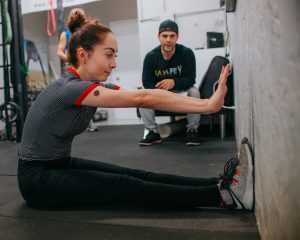When you wake up in the morning and stretch your arms out, your body feels an instant release from the stiffness and tightness that a night of sleeping has brought on. This is because, for the most part, the average adult lies in one position for long periods of time during the course of 6 to 8 hours of sleep. In this time, your muscles may begin to relax, however, they still require light stretching, along with your joints that become stiff due to being idle.
Similarly, many job professions do not encourage much movement during work hours, thus leading to several health problems which include taking a major toll on one’s mobility and flexibility. Additionally, muscles in the body can become tight and shorten if they are not stretched on a regular basis while range of motion in joints is also reduced. The consequences of the above include aches and pains, and makes you more prone to injury.
The good news is, even if you have given stretching little importance during the better half of your life, it is not too late to prioritise it and yield the benefits. Speaking of which, let’s take a look at how stretching can help both the body and mind.
8 Major Benefits of Stretching
Although you may not experience all the benefits of daily stretching overnight, sooner rather than later, you will notice the difference in how your body is moving and functioning. With that in mind, let’s take a quick look at the major advantages of stretching your body every day.
1. Increased Flexibility
Poor flexibility makes you prone to all sorts of injuries; therefore, is it critically important to work on increasing and improving your flexibility by stretching. The additional benefit is that it slows down the process of limited mobility which is inevitable as the body ages.
2. Increased Range of Motion in Joints
When range of motion in certain joints are restricted, your ability to move freely is limited. It can also lead to pain when trying to force the joint to move outside of its current range of motion. Stretching is an excellent way to help joints reach their full range of motion over time.
3. Better Posture
Stretching encourages better posture by making the individual more aware of their habit of rounding the back. When used in combination with strength training, it helps to correct muscle imbalances which, in turn, aid in improving one’s posture.
4. Improved Physical Performance
There are multiple ways in which stretching can benefit your physical performance, as well as prevent muscle injuries. The act of warming up and stretching before you engage in any sport or physical activity ensures that your muscles are loose and prepared to be worked. The benefit here is that, when your muscles are ready for the activity, you are able to perform better.
5. Improved Blood Circulation
When there is not enough blood circulating to muscles, they take longer to recover. This comes with its own set of problems including prolonged muscle soreness and discomfort/pain. Stretching helps to increase the blood flow to your muscles, thus reducing or eliminating the onset of muscle related problems.
6. Reduces/Prevents Back Pain
Back pain can be caused by a number of underlying issues while treatment also varies. Although chiropractic for back pain is commonly sought after, stretching is also effective in alleviating back pain that is caused by strained muscles. Daily stretching has also been proven to prevent back pain by simply keeping the muscles in the back strong and healthy.
7. Reduced Mental Stress
Similar to meditation, when you are focused on stretching, it helps relax your mind which, in turn, reduces mental stress. The relief from tightness and stiffness in your body during the course of the day also helps to keep your mind calmer and less stressed.
8. Your Body Feels Better Overall
Over the course of time, daily or regular stretching will leave your body feeling limber with the added benefit of freedom from aches and pains that are caused by muscle strains, stiffness, and the likes. You will also find that day-to-day activities which include working and performing physical activities, take a lesser toll on your body due to your increased flexibility and mobility.
How to Start Stretching for a Beginner

There are various techniques of stretches one can do, many of which have targeted goals. Dynamic and static stretches are the two most common types, and serve different purposes as mentioned below:
- Static Stretching is when you stretch and hold the position for a specific amount of time (usually between 10-30 seconds), and is recommended after performing a physical activity
- Dynamic Stretching involves fluid or continuous movements that stretch the muscles for 10 – 20 seconds; it is generally performed before workouts or physical activities
Tips to Begin a Stretching Routine
For anyone that has never followed a stretching routine before, it is important to start slow and allow your body to adjust to these new movements. By taking it slow, you will also be able to learn the correct technique and form required for each stretch.
Here are the most important tips to keep in mind when you begin stretching:
- Always warm-up before you stretch; this can be done by performing any light cardio including walking, jogging, cycling, jumping jacks, etc
- Focus on your breathing when stretching; take deep breaths during each stretch
- Stretch both sides of your body equally
- Avoid forcing a stretch if it is painful or too uncomfortable; do what feels natural and/or within your range of motion
- Perform each stretch slowly as opposed to sudden, jerking movements
- When performing static stretches, hold the position for at least 10 seconds or longer if you are comfortable
- Stretch for 5 – 10 minutes daily, and gradually increase the time and types of stretches as your body gets used to it
IMPORTANT: If you have injuries or underlying medical issues that limit your physical activity, it is highly recommended that you speak with your physician before beginning a stretching routine.
If you would like to learn how to stretch under the guidance of a trained medical professional, or are seeking treatment for sore muscles, back pain, and other related problems, MSK Therapy offers a wide range of non-invasive treatments including chiropractic, physical therapy, and massage therapy. We often use a combination of customised treatment plans to help individuals heal and feel their best by treating the underlying cause of a medical condition.

